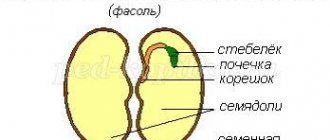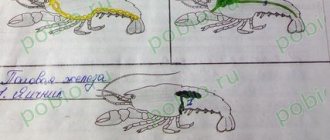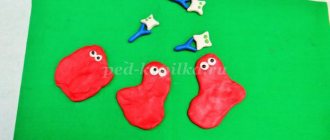Biology lesson in 5th grade (FSES) on the topic “Bacteria” with presentation.
Lesson 12
Lesson topic:
Bacteria.
Goals:
Subject-didactic:
the formation of ideas about the distinctive features of representatives of the kingdom of Bacteria and their significance in nature and in human life.
Activity:
creating conditions for students to develop the ability to discover new knowledge through performing practical tasks and finding solutions to problematic issues.
Expected results:
Personal:
- Students are ready to perceive the scientific picture of the world, to self-development and self-education;
- Responsible for completing educational tasks;
- Demonstrate communicative competence and respect for the opinion of another person.
Metasubject:
- Set a learning task under the guidance of a teacher and work in accordance with it;
- They put forward the simplest hypotheses;
- The main, essential features of concepts are highlighted; make comparisons, express judgments, give reasons for them;
- Work with information and transform it;
- Find cause-and-effect relationships;
- Evaluate their work and the work of their classmates.
Subject:
- They know the distinctive features of a bacterial cell, they can identify bacteria in pictures in comparison with representatives of other kingdoms;
- Have an idea of the distribution of bacteria on Earth, the characteristics of their life activity;
- Give examples of the importance of bacteria in nature and in human life; measures to prevent bacterial infections.
Lesson type:
- For the leading didactic purpose:
lesson on learning new material;
- By way of organizing activities:
individual-group;
- According to the leading teaching method:
problem-search.
Methods:
- Basic:
problem-search (solving problematic problems);
- Additional:
- verbal (conversation, dialogue);
- visual (working with drawings, diagrams);
- practical (drawing diagrams, searching for information, working with an interactive voting system);
- deductive (analysis, application of knowledge, generalization).
Main questions:
- Habitats and essential characteristics of bacteria: cell structure and life forms;
- Life processes: nutrition, reproduction, spore formation;
- The importance of bacteria in nature and in human life;
- Measures to prevent bacterial infections.
Means of education:
- Textbook Sonin N. I. Biology. Introduction to biology. 5th grade. M.: Bustard, 2012;
- Workbook for the textbook;
- TsOR “Division of a bacterial cell”, “Spore formation in bacteria”.
- Additional text material;
- Presentation "Bacteria";
- Evaluation paper.
Equipment:
multimedia projector, screen, computer, interactive voting system.
During the classes
I.Organizational moment
II . Updating the basic knowledge of the lesson, checking homework
- Test “Diversity of Living Things” (according to options), p. 41-43
- Frontal conversation.
—What does the science of taxonomy study? (Diversity and classification of living organisms)
— Why was there a need to classify and systematize living organisms? (To study living nature.)
-What is a species? (A species is a collection of individuals similar in characteristics, living in a certain territory and producing fertile offspring.)
— Name the scientist who introduced the binary naming system (Carl Linnaeus)
— Based on what criteria are plants and animals classified into systematic categories? (Kinship, similarity of structure.)
—What kingdoms are distinguished in living nature? (Bacteria, fungi, plants, animals.)
— By what criteria can living organisms of different kingdoms of living nature be divided ? (By size - bacteria; by type of nutrition - mushrooms and animals; by ability to move - mushrooms and plants; by structure)
— Name the representatives of the animal kingdom.
— Name the representatives of the plant kingdom.
— In what properties do plants differ from animals? (Immobility, no reflexes, grow indefinitely throughout their life, can independently create nutrients).
—What is the diversity of living organisms? (4 kingdoms, many orders, classes, species.)
— What magnifying devices do you know? (Magnifying glass, microscope)
III. Motivation to learn new material. Formulating the topic and purpose of the lesson.
In biology lessons we will get acquainted with different groups of organisms.
Among the variety of living organisms, there are some that we cannot see with the naked eye. These organisms can be studied using magnifying instruments, namely a microscope.
Slide 1.
These living organisms appeared and spread on Earth earlier than others. They were discovered in 1676 by Anthony Van Leeuwenhoek. He saw them using an optical microscope and classified them as a group of microscopic organisms. They participate in the cycle of substances on the planet; thanks to their work, chemical substances are transformed. A person uses them for his own purposes: he receives fermented milk products, sauerkraut, vitamins, and some medications. Also, these organisms can play a negative role in nature and human life: they are causative agents of various diseases. They are found in soil, air, water, and live in the bodies of other organisms, found in geysers, salt lakes such as the Dead Sea, in Antarctica and the Arctic, and can even live in reactors of nuclear power plants. I think you have already guessed what organisms we are talking about.
— Who will announce the topic of the lesson?
— We will begin our study of the kingdoms of nature with the study of bacteria. Today we will talk about them.
Slide 2.
What would you like to learn in class? What questions should I get answers to?
IV . Assimilation of new knowledge and methods of action.
Work according to the textbook. Notes in the workbook.
— The word “bacteria” comes from the Greek “bacterion”, which means stick. Rod-shaped bacteria are called “bacilli”, spherical single ones are called “cocci”. If spherical bacteria are combined in groups of 2, such bacteria are called “diplococci”. But staphylococci are shaped like bunches of grapes. There are also curved, spiral and other forms of bacteria. You can study the different forms of bacteria in more detail in high school.
— On the outside, bacterial cells are covered with a membrane, or capsule, that protects the cell from external influences. Also on the outer cell membrane there are villi or flagella, with the help of which bacteria move. Bacteria are very active organisms; they move and feed a lot. Some bacteria are capable of creating nutrients themselves, but most of them feed on ready-made substances: at the expense of other organisms, like parasites, the bodies of other organisms or their dead remains. Bacteria reproduce by normal division; when one mother cell divides in two and forms two new daughter cells. The average time for bacterial division is 20 minutes. In favorable conditions, bacteria multiply quickly. And when unfavorable conditions occur, they turn into a cyst. The cyste bacterium can survive both high and very low temperatures, as well as lack of moisture. If the conditions necessary for the life of the bacterium reappear, the cyst shell ruptures, and the bacterium continues its life. And the vital activity of bacteria can occur everywhere: in the air, soil, water, on living organisms and even inside their bodies. Bacteria living in the soil layer process the remains of living organisms, turning them into minerals, and participate in the formation of humus. But in nature there are also pathogenic bacteria that cause various diseases, for example, tuberculosis, typhoid fever, plague, cholera. All these diseases claim a large number of people's lives. Man took control over cholera and plague into his own hands. The task of biology and medicine is the development of vaccines or methods of treating and preventing diseases caused by bacteria.
— What methods can we follow to prevent diseases caused by bacteria? (get vaccinated, wash your hands, maintain hygiene, handle food properly, take vitamins, etc.).
-In order to properly prevent diseases that can be caused by bacteria, it is necessary to follow the basic rules of hygiene: wash your hands thoroughly before eating - after going outside or working, ventilate the premises, do not eat spoiled or expired products: they may contain pathogenic bacteria that are harmful to health.
— What do you think, what positive role do bacteria play in nature and human life? (Children's answer)
Read about this in the textbook on p. 62, 2nd-3rd paragraph)
Bacteria existed on our planet several billion years ago, but people learned about them relatively recently. Why?
Slide 3.
Which organisms shown on the slide cannot be classified as bacteria? Why?
Slide 4.
On the screen you see two organisms. Are they bacteria? Why? You can work individually or in pairs.
Textbook § 11, p. 60.
So, we were able to distinguish a bacterium from another single-celled organism. Complete task 64, p. 34
workbook.
Let's work with the diagram of a bacterial cell in the workbook (task No. 65, p. 34)
.
Who wants to show the main parts of a bacterial cell in a drawing?
Slide 5.
The shapes of bacterial cells are varied.
What process underlies the increase in bacterial numbers? How do you think bacteria can reproduce?
task No. 67 in your workbook 34
Slide 6.
In groups, analyze the information on the slide and make a guess about the nutrition of bacteria.
What happens to bacteria under unfavorable conditions? Discuss the question in a group and make an assumption.
Is it possible to live without bacteria on Earth?
V. Primary consolidation of the studied material
General conversation.
— Why do scientists believe that bacteria are the first living organisms on Earth? (They have a simple structure, do not have a core, and can survive unfavorable environmental conditions).
— Thanks to what structural features can bacteria tolerate unfavorable living conditions? (dura, cyst)
—Where can bacteria live? (in water, air, soil, living organisms)
—What are the structural features of bacteria? (externally covered with a shell, do not have a nucleus, have locomotion organs such as flagella or cilia)
— What is the positive role of bacteria in nature and human life? (Soil bacteria are involved in the formation of humus and soil. As a result of the vital activity of bacteria, ore deposits and natural gas reserves were formed. They participate in the destruction of dead tissues of plants and animals).
— What is the negative role of bacteria? (Painful bacteria cause diseases in humans and animals.
Slides 8 – 15.
Formulate a conclusion about the importance of bacteria in nature and in human life.
VI . Summarizing
— What new did you learn in the lesson?
— What difficulties did you encounter while working in class?
Today we got acquainted with the kingdom of Bacteria. Now let's take the test forms and answer a few questions about bacteria.
Let's check the answers. Who answered all 5 questions correctly?
Let's return to the goals set at the beginning of the lesson. Did you manage to achieve them? Are you satisfied with the work in the lesson?
. Homework:
§ 11, questions on p. 63 (u), tasks p. t. No. 63, 68 – 72, at least 3 optional.
Appendix to the outline plan for an open biology lesson in grade 5 on the topic “Bacteria”
Additional information for group work
Based on the results of the vital activity of bacteria, several groups are distinguished.
Rotting bacteria
decompose organic matter of dead plants and animals, excretions of living organisms and other organic waste, transform them into humus, thus participating in the formation of soil. Bacteria of putrefaction are a kind of orderlies of our planet.
The next group is soil bacteria.
They process humus into minerals, which can again be absorbed by plants from the soil.
There are bacteria that are able to absorb nitrogen from the air and convert it into a state suitable for further use by plants. We can say that these bacteria produce natural nitrogen fertilizers. They settle on the roots of leguminous plants, such as peas, beans, clover, and alfalfa, forming nodules on them, and therefore are called nodule bacteria.
Under the influence of lactic acid bacteria
milk turns into yogurt, cream into sour cream. They also participate in the ripening of cabbage.
There are bacteria living in the human intestines (from 300 to 1000 species). Scientists believe that their total mass can reach 1 kg, and the number of their cells is 10 times greater than the number of cells in the human body. They play an important role in digestion, synthesize vitamins necessary for humans, and displace pathogenic harmful bacteria. We can say that the human microflora is an additional “organ” involved in digesting food and protecting the body from infections.
The activity of bacteria can be assessed not only positively. Bacteria bring us a lot of trouble, the activity of which leads to spoilage of food ( rotting bacteria
). They are the ones who force us to store food in the refrigerator. To prevent food from spoiling, they are salted, dried, candied, pickled, preserved, that is, they create unfavorable conditions for bacteria.
Cellulose-degrading bacteria
They spoil books in book depositories, causing irreparable damage, for example, when under their influence the pages of ancient manuscripts crumble.
Some types of bacteria ( pathogenic
) settle in the bodies of plants, animals, and humans, poisoning them with the products of their vital activity, that is, causing disease. For example, in humans, bacterial diseases include tonsillitis, tuberculosis, dysentery, diphtheria, cholera, typhoid, plague and many others.
To avoid bacterial infection, you need to follow certain rules: store and prepare food correctly, wash vegetables and fruits, do not drink raw water, keep your body and home clean, and get preventive vaccinations on time. Bacteria are killed when exposed to high temperatures, direct sunlight, or exposure to disinfectants such as bleach.
Questions for interactive testing on the topic “Bacteria”
A1. Bacteria are organisms:
- only unicellular;
- only multicellular;
- both unicellular and multicellular.
A2. A bacterial cell contains:
- shell, cytoplasm, nucleus;
- cytoplasm, nucleus, nucleic acid;
- membrane, cytoplasm, nucleic acid.
A3. Bacteria:
- feed on ready-made nutrients;
- are able to create nutrients themselves;
- 1 and 2 are correct.
A4. Determine the correct statement.
- Bacteria reproduce by spores.
- Spores help bacteria survive unfavorable conditions and spread.
- Bacterial spores die quickly in unfavorable conditions.
A5. Determine the correct statement.
- All bacteria cause harm to other living organisms.
- Cellulose-degrading bacteria benefit humans.
- Man uses bacteria to create some food products.
Features of life
Based on the type of nutrition, bacteria can be divided into two groups: autotrophs and heterotrophs. Let us dwell in more detail on the features of these groups.
Autotrophic bacteria include blue-green or cyanobacteria. They are considered the only bacteria capable of producing finished organic substances through photosynthesis, since the cells of cyanobacteria have a green pigment - chlorophyll. Therefore, cyanobacteria create their own substances for nutrition.
Blue-green or cyanobacteria
In previous eras, bacteria were the first organisms on the planet. Accordingly, the importance of cyanobacteria was very high in the accumulation of oxygen. Before the advent of plants, cyanobacteria served as the main source of oxygen for the Earth's atmosphere.
Almost all bacteria lack chlorophyll, which is characteristic of plants; accordingly, these types of creatures are not able to form the organic substances required for their nutrition. The vast majority of these organisms cannot live in sunlight and prefer darkness.
Therefore, they use ready-made organic substances for their nutrition. They absorb solutions over the entire surface of their body.
Bacteria that consume ready-made organic substances are divided into saprotrophs and parasites based on their feeding method.
Bacteria that settle on dead organisms and feed on their substances are called saprotrophs. In the process of feeding saprotroph bacteria, the remains of other creatures rot. Examples of saprotrophs include Escherichia coli and Pseudomonas aeruginosa.
Pseudomonas aeruginosa
Other bacteria live in the body of other organisms, which is why they are called parasites. The habitat can be the body of people, animals, and sometimes plants. For their nutrition, bacteria and parasites use organic substances from the cells of living beings. Parasitic bacteria cause various diseases in humans. An example of parasitic bacteria is the plague bacillus, which causes a disease such as plague.
Plague stick
Bacteria reproduce by dividing their cells. Every bacterial cell is split in half, and two organisms are formed from one organism. The growth and reproduction of bacteria occurs unusually quickly. For example, a cholera cell splits into two and after 30 minutes it is able to multiply again.
Under suitable conditions, the reproduction of cholera bacteria occurs intensively. Accordingly, within 30 hours, at such a rate of reproduction, the formation of a huge number of bacteria is possible, so that it could cover the entire surface of the globe with a film. However, this does not happen, since microorganisms do not find enough food for themselves and die in droves. Also harmful to them are the effects of sunlight, lack of moisture, and high temperatures.
Bacteria in the cycle of substances
Microorganisms in general and bacteria in particular play a large role in the biologically important cycles of substances on Earth, carrying out chemical transformations that are completely inaccessible to either plants or animals. Different stages of the cycle of elements are carried out by organisms of different types. The existence of each individual group of organisms depends on the chemical transformation of elements carried out by other groups.
Nitrogen cycle
The cyclic transformation of nitrogenous compounds plays a primary role in supplying the necessary forms of nitrogen to organisms of the biosphere with different nutritional needs. Over 90% of total nitrogen fixation is due to the metabolic activity of certain bacteria.
Carbon cycle
The biological transformation of organic carbon into carbon dioxide, accompanied by the reduction of molecular oxygen, requires the joint metabolic activity of various microorganisms. Many aerobic bacteria carry out complete oxidation of organic substances. Under aerobic conditions, organic compounds are initially broken down by fermentation, and the organic end products of fermentation are further oxidized by anaerobic respiration if inorganic hydrogen acceptors (nitrate, sulfate or CO2) are present.
Sulfur cycle
Sulfur is available to living organisms mainly in the form of soluble sulfates or reduced organic sulfur compounds.
Use of bacteria
Many types of bacteria are useful in human economic activities. So, thanks to lactic acid bacteria, you can get products that many people cannot imagine their diet without. Among them are fermented milk products (ryazhenka, kefir, yogurt), cheeses, and sauerkraut.
The pharmaceutical industry uses the waste products of certain bacteria as a basis to create the most powerful antibiotics.
The role of bacteria in nature has many directions. It is safe to say that scientists still have many discoveries to shed light on the activities of these microorganisms.
Education dispute
Bacteria are not always in optimal conditions for their existence. Often they may find themselves in unfavorable conditions, and then some of them develop spores.
How does the process of spore formation proceed? Let's consider the main stages of spore formation.
When exposed to poor conditions, such as sudden temperature changes, lack of moisture or food, they stop moving and feeding. The cytoplasm inside the cell is compressed and a very strong shell is formed. This form of bacterial life is called a spore.
Bacterial spores
Likewise, microorganisms can tolerate dryness and cold. In this state, the body is at rest - all vital processes slow down. It can be compared to hibernation in animals.
In the form of resting spores, bacteria survive unfavorable conditions. Along with the dust, the spores are carried by the wind. Once in good living conditions, the spores turn into bacteria. Therefore, the method of spore formation provides bacteria with life on the planet.






